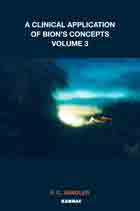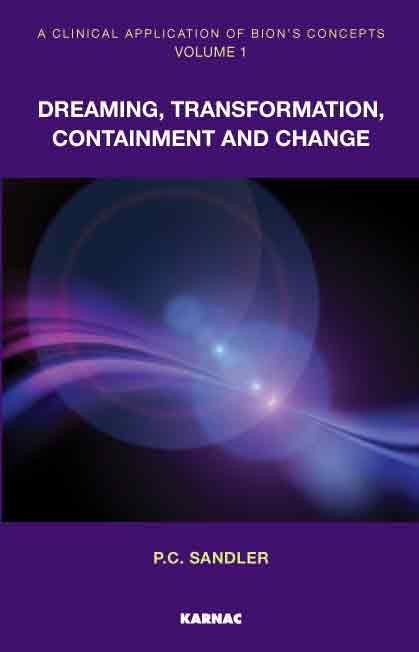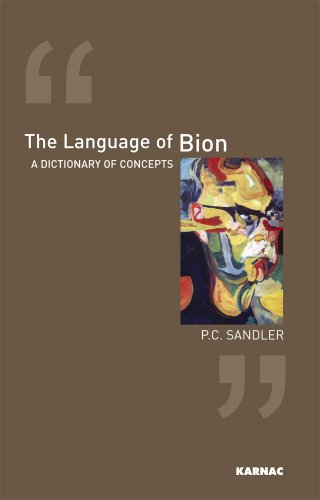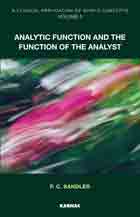A Clinical Application of Bion's Concepts: Volume 3: Verbal and Visual Approaches to Reality

Book Details
- Publisher : Routledge
- Published : January 2013
- Cover : Paperback
- Pages : 314
- Category :
Psychoanalysis - Catalogue No : 32699
- ISBN 13 : 9781780490687
- ISBN 10 : 1780490682
Also by P.C. Sandler
The Language of Bion: A Dictionary of Concepts
Price £66.99
There are currently no reviews
Be the first to review
The final book in the three-volume series, A Clinical Application of Bion’s Concepts – a practical companion to the dictionary of concepts The Language of Bion - is divided in four main parts. Part I, through the aid of a transdisciplinary study between psycho-analysis, mathematics, and physics, proposes four expanded variations of Bion’s epistemological tool, The Grid. This was construed around an Euclidean space represented graphically by two dimensions constantly conjoined: the dimension of Functions of the Ego with the dimension of Psycho-genetics of thought processes. Bion’s tool, by its own design, allows possibilities of development with regards to its ability to scrutinize the ‘truth-value’ of statements issued both by patients and analysts in the space-time, or the ‘here and now’ of psycho-analytic sessions or groups of sessions. The proposal is made though three steps; each one adds a subsequent dimension to the earlier one considered. The first step constitutes a Tri-dimension Grid; the added dimension is the Intensity of phenomena observed though the aid of the two dimension, original Grid. From this is proposed a Four-dimension Grid, which examines the evolution of the session with another dimension, added to the three already mentioned: the dimension of Time. Developing out from this, is proposed the a Six-dimension Grid, with the aid of more recent developments which allow a more precise examination of the space-time unit as observed by mathematicians and physicians. Finally, in order to better illuminate the complexity of mental functioning, there is proposed a Multi-dimension Grid. There is a detailed clinical illustration to furnish an example of the use of the Grid.
Part II is a study of the most elemental bearings of the psycho-analytic clinic – free associations and free floating attention - which evolves from the study of Dreams, under the contributions of Bion (presented in volume I), as well as from the study of the analytic function and the function of the analyst (presented in volume II). In Part III Sandler shows how the pursuit of truth can be seen as one of the purposes of the psycho-analytic investigation in the clinic; a transdisciplinary study is presented, to assist the practicing analyst, around epistemological issues. Freud and Bion’s contributions to it are scrutinized under some lights hitherto unused in the psycho-analytic literature. Part IV presents Sandler’s proposals for expanding the observational power of existing Bion’s theories; in this part another basic assumption, based on the original three proposed by Bion, is described, in connection with his contributions to the study of hallucinosis.
Reviews and Endorsements
‘This closing volume of the series A Clinical Application of Bion’s Concepts presents many correlations which link remarkable theories from Bion with a detailed selection of personal clinical experiences spanning almost four decades of psychoanalytic practice. The reader is invited to get in touch with theories of observation devised by Bion in the 1960s — which, alas, are still unknown to a sizeable number of members of the psychoanalytic movement. Starting from Bion, Sandler proposes models and modulating tools borrowed from mathematics and physics. Part I is a significant metapsychological
work and requests conditions of receptive minds, endowed with discipline and daring, to foster our adventure into exploring the Unknown in our clinical practice.
‘Despite its eminently practical intention, the book presents to some readers agreeable surprises in the form of developing theoretical elaborations. Some readers may feel the path travelled by Sandler as shocking: sometimes full of awe and fright. As in most situations like that, it may promote sensible and energetic rewards. I dare to say that “A personal equation in two movements” demands a loving reader equipped with courage and strict confidence, and shielded by mature compassion!’
- From the Introduction by Antonio Sapienza
About the Author(s)
Paulo Cesar Sandler, MD, MSc, MhFAB, is a Training Analyst at the Sociedade Brasileira de Psicanálise de São Paulo, Psychiatrist at the Institute of Physical Medicine and Rehabilitation (IMREA) at the Hospital das Clinicas, Faculdade de Medicina da Universidade de São Paulo, and author of several books in Portuguese. He has written many papers and book chapters, some of which have been published in English and French. He has translated most of Bion's books and papers into Portuguese and has organized several international meetings on the work of Bion. Dr Sandler currently teaches in a post-graduate course at the University of São Paulo, and at the Institute of Psycho-Analysis of the SBPSP, giving courses about the work of Freud, Klein and Bion. He has worked in private psychoanalytic practice since 1974, having previously worked with psychotics in a traditional in-patient clinic, as well as in group-oriented community psychiatry, including epidemiology of mental disorders, in the local Public Health School.
Customer Reviews
Our customers have not yet reviewed this title. Be the first add your own review for this title.
You may also like
The Patient and the Analyst: The Basis of the Psychoanalytic Process
Joseph Sandler
Price £33.29
save £3.70
A Clinical Application of Bion's Concepts: Volume 2: Analytic Function and the...
P.C. Sandler
Price £35.99
The Soft Power of Culture: Art, Transitional Space, Death and Play
Jonathan Sklar
Price £26.99
save £3.00








